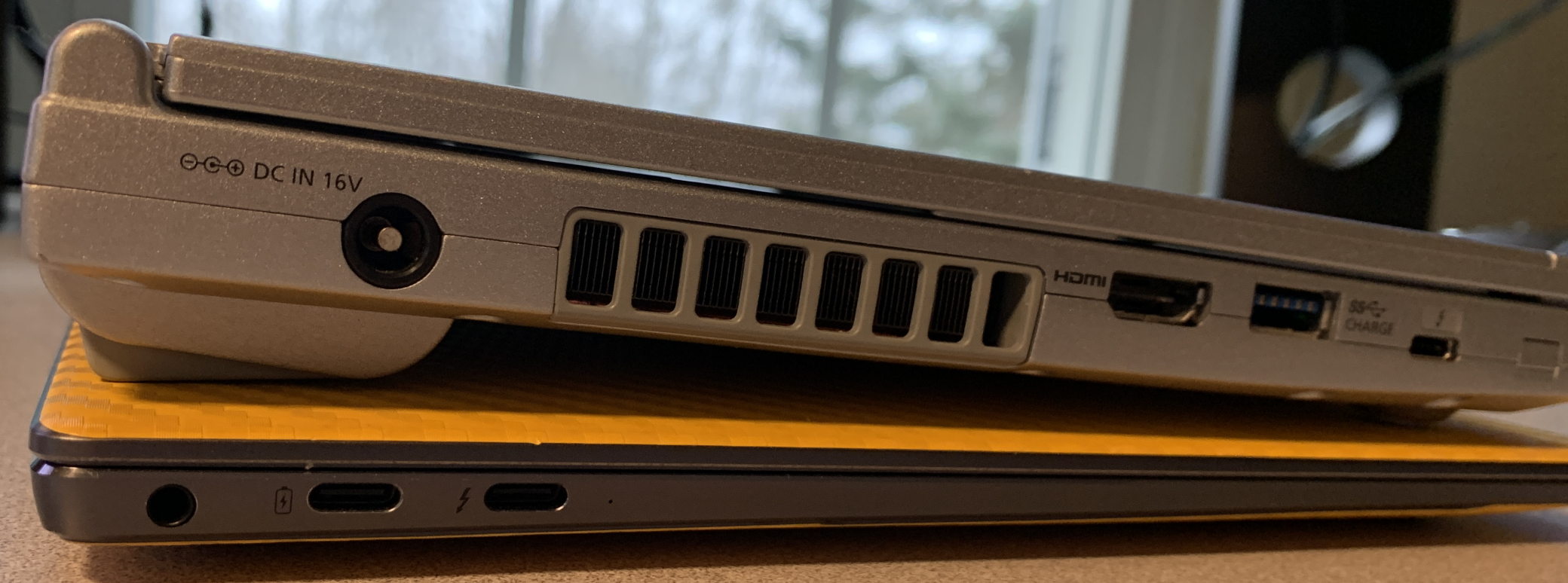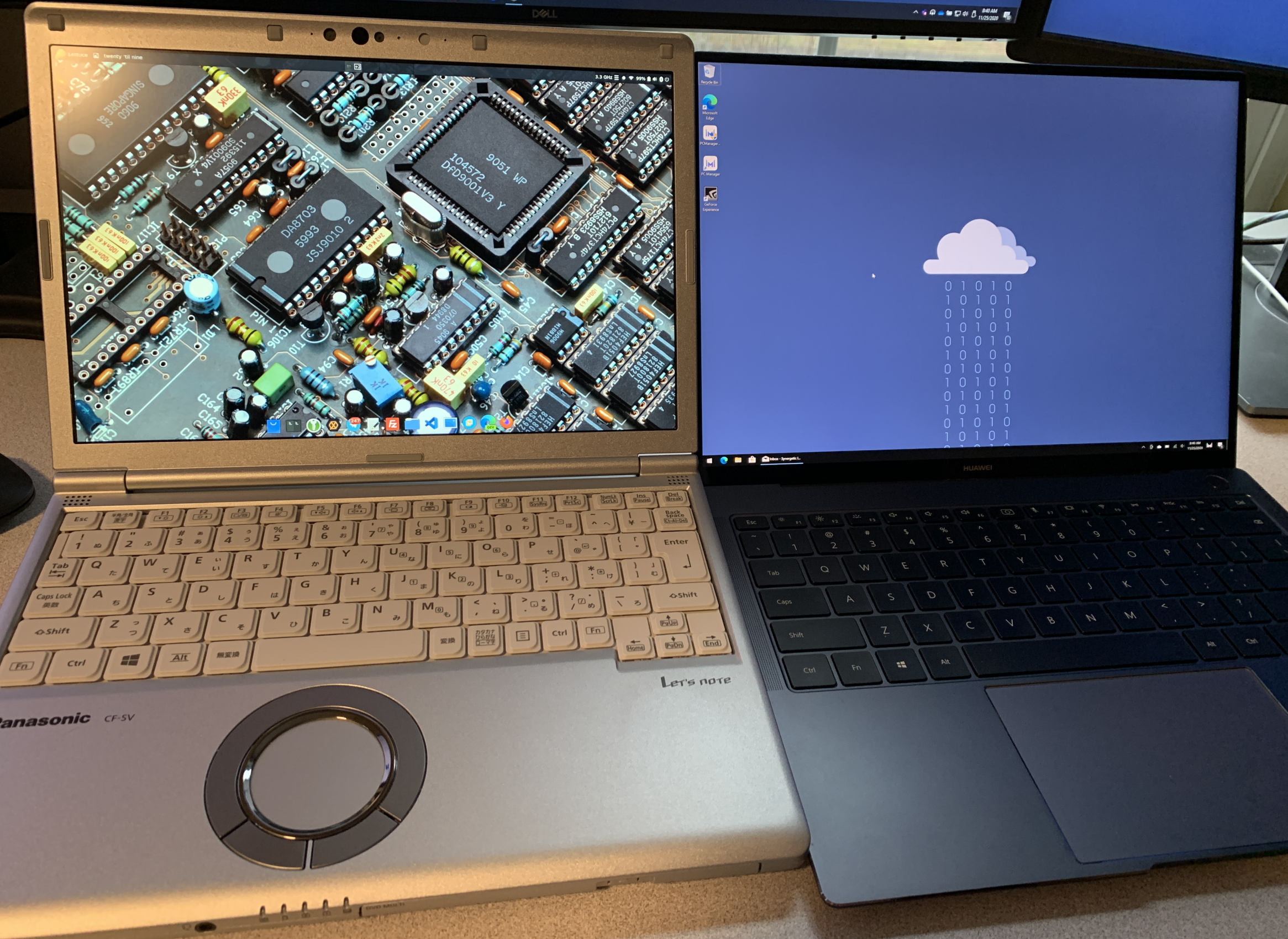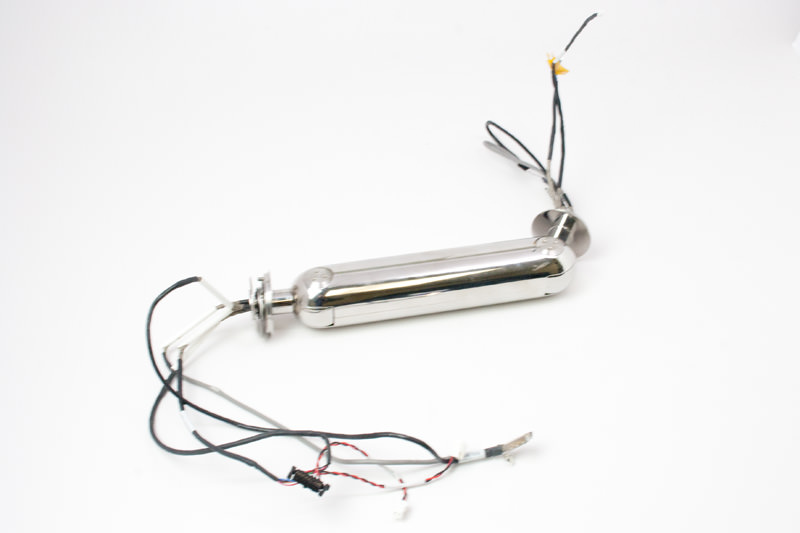Last night, I traded my iPad Pro for a Huawei MateBook X Pro (2018) (hereafter "matebook") and now I'm going to spend some time comparing this laptop to my current laptop, a Panasonic Let's Note CF-SV8 (hereafter "SV8"). Both machines are very similar in some ways and incredibly different in others, so I thought I might take the opportunity to write a little bit about this. This is not a review of either machine and is probably a bit premature as I've had the SV8 for a few months and the matebook only a few hours.
Lets start with the objective boring stuff, the specs.
|
SV8 (CF-SV8RDAVS) |
MateBook |
| CPU |
i5-8365U 4c/8t 1.6GHz Base, 4.1GHz boost, 6MB L3, 15w |
i7-8550U 4c/8t 1.8GHz Base, 4.0GHz boost, 8MB L3, 15w |
| RAM |
8GB LPDDR3-2133 (soldered) |
16GB LPDDR3-2133 (soldered) |
| GPU |
Intel UHD |
Intel UHD 620 & Nvidia GeForce MX150 |
| SSD |
256GB m.2 NVMe 2280 |
512GB m.2 NVMe 2280 |
| Other Storage |
DVD-RW & SD XC slot |
- |
| Ports |
3x USB3.0, USB-C Thunderbolt 3, HDMI, VGA, 1GbE Ethernet, Headset, 16v power |
1x USB3.0, USB-C Thunderbolt 3, USB-C 3.0 (data & power), Headset |
| Networking |
Intel I219-LM Ethernet, Intel Canon Point-LP CNVi Wireless-AC |
Intel Wireless-AC 8275 |
| Screen |
1920x1200, 12.1" |
3000x2000, 13.9", capacitive multitouch |
| Dimensions |
283x204x25mm (11.1x8x1in) |
304x217x15mm (12x8.5x0.6in) |
| Weight |
1Kg (2.2lbs) |
1.3Kg (2.9lbs) |
| Battery |
43Wh (5900mAh 7.2v) removeable |
56Wh (7410mAh 7.6v) fixed |
| Other |
Indicator LEDs, Windows Hello camera support, full magnesium chassis |
Backlit keyboard, fingerprint reader |
| Retail Price (Approx.) |
$2,200 |
$1,700 |
So, what does this tell us? Well, these are both "thin and light" medium/high class machines from 2018, though their target audiences are very different. The SV8 isn't even sold in the US, and is targeted squarely at Japanese businessmen wanting a high end and very practical Windows laptop with good connectivity and great battery life. The matebook, on the otherhand, is sold worldwide and is targeted at people who want a Mac but want to run Windows on it for slightly less than Apple prices. It's a high end machine, but not really suitable for "traditional business use" and it suffers from the port-deletes found on most similar thin and light laptops today.
Aside from the differences in CPU and RAM (which, I think it's worth mentioning - the SV8 is available in an i7/16 config, and the matebook is available in an i5/8 config) the largest difference between the two from a hardware perspective is that the SV8 has an integral full-size optical drive, which, for a 12" laptop in 2018, is nothing short of incredible. It's not something I need or use, and in fact I have it disabled in the BIOS, but I can understand how some see the appeal. Optical drive delete models exist and are approx. 100g lighter, but they don't seem to be very common. Additionally, the matebook includes a dedicated Nvidia MX150 GPU. This is a GPU suitable for "light gaming" (eSports Titles and the like) and something I would just as soon not have. It's not possible to disable entirely in the BIOS, but it's trivial to do so in both Windows and Linux. Doing so, of course, increases battery life. Personally, I find the inclusion of a dGPU for occasional 3D tasks to be more beneficial than an optical drive. I can plug in a USB optical drive, but eGPUs are decidedly more of a pain.
I don't use a laptop as my primary machine, so lots of RAM and a powerful CPU are much less relevant to me. The SV8 has performed every task I have cared to throw at it handily, and while I haven't done as much on the matebook, I expect it to perform just as well. I have benchmarked both machines, both with Geekbench 5.3.1 and an xz compression test if the reader is interested in raw numbers.
Both machines have beautiful screens. The matebook's panel is glossy, however, because it's also a touch screen, which is not something I care for. I don't mind glossy panels, but I know that some hate them. I rarely, if ever, use a computer outdoors, and I try and avoid situations with bright overhead lighting when I can. 3000x2000 at 13.9" on the matebook is far too high a DPI for me to use at 100%, but 200% is too large. 150% feels just right in windows, but fractional scaling suffers considerably under linux, and may even be impossible when using the Nvidia GPU. I would prefer to run my display at 100% under all circumstances, but on the matebook it's just not possible for me without reading glasses. The SV8's panel, by comparison, is 1920x1200 at 12.1", and I find it very usable at 100%. There are times when my eyes are a bit more "tired" and focusing on the smaller characters is a bit of a struggle, but this can quickly be resolved by blowing up my web browser or terminal to 125-150%. Both panels are better than a typical 1920x1080 display due to the added vertical height. The matebook is 3:2 and the SV8 is 3.2:2. Both are wonderful, but the added height on the matebook wins for me.
On the question of input devices, it's no question that the matebook wins for me. The keyboard is wider with larger keys, and it has a more standard American layout that I am used to elsewhere. The keys have good travel and feel, and nothing wobbles or bends when typing. It's not the SV8's fault for having a JIS keyboard, as it is a machine primarily sold in Japan, rather it's my fault for using a JIS keyboard in an American layout. The SV8's keyboard has many keys that are specific to inputting Japanese text, which are unused by me, and I would prefer they not be there at all to make the other keys larger. There is a configuration of the SV8 that is sold in Singapore which has an American style keyboard, but I have not been able to find one of these yet. I also suspect if I had smaller hands I would like the SV8's keyboard more. The SV8 keyboard does win out in a few ways, though: it has a contextual menu key, which I use daily, it has dedicated Insert/Delete keys (the matebook only has delete), and the arrow keys are in the "normal" inverted-T configuration, rather than the mushed macbook-style that the matebook adopted. The feel of the SV8 keyboard is "fine", on the mushier side but not bad. It also feels very rigidly affixed to the case. The matebook's is also backlit, which I appreciate; the SV8's is not.
I almost always use a bluetooth mouse when using a laptop on a table, but I'll use the trackpad plenty around the house or when traveling. The matebook has a gigantic glass covered trackpad, much in Apple's style, and it feels great and is very responsive. The SV8's trackpad is also very responsive, and it's unique circular shape is interesting, but it is very small, which can be frustrating at times. The dedicated buttons of the SV8 are nice, but missing them on the matebook isn't a dealbreaker. Something I wish both had was the ability to turn off the trackpad from a function key. If I'm using a mouse, I often don't want any input from the trackpad.
The matebook's thinness causes it to loose the I/O battle without question. A single USB3-A, two USB-C (one of which is TB3) and a headset jack. That's it. Not even an SD card slot. The SV8 on the other hand comes in with a full compliment - three USB3-As, a USB-C for TB3, HDMI and VGA, ethernet, and a dedicated barrel jack for power. The SV8 also has a full compliment of indicator LEDs: power status, lock keys, and activity of HDD and SD while the matebook only has a charging LED on the side. USB-C charging is an option for both machines - the matebook requires it with no alternative, and the SV8 supports it as long as the machine is either running or in standby. For some reason it won't charge from USB-C if it's powered off - I haven't figured out why. Both support Windows Hello if you're into that sort of thing - the SV8 has the IR camera while the matebook has a fingerprint reader on the power button. I don't use either. The webcams on both are good, though the SV8's is clearly better, full 1080p. The matebook's is 720, and it pops up out of the keyboard between the F6 and F7 keys, which is a very peculiar feature. It does enable the screen area on the matebook to completely fill the lid, which is very attractive. The matebook has fairly full-sounding speakers which can be incredibly loud, which is something I find frustrating. In Windows I find the 10-15 volume level to be appropriate. The SV8's speakers are "fine" but definitely not something I would want to use for listening to music, contrary to the matebook. I haven't used the microphones on either, but I imagine they're both pretty bad, but acceptable in a pinch.


I don't know how Huawei's batteries track over time, but I don't have a tremendous amount of confidence in it's long term capacity. The SV8, on the other hand, I expect to retain near-original capacity for years, as has been reported by other Let's Note owners. Panasonic is just really good at batteries, go figure. I have never needed to go more than about 5 hours on a charge, and both machines will do so easily. The 43 watt hour battery in the SV8 is reported to last up to 13 hours under light duty loads, and I can believe that. The matebook is advertised as lasting 12 hours, which I do not believe. Reviewers have placed it at the seven to nine hour mark, which as I have stated is plenty enough for me. I don't know if I will be able to get a replacement for either, should I ever need one.
So, aesthetics. The matebook is boring. Lots of people will probably find it to be very sexy and attractive, but it's just a 13" MacBook Pro clone. It does a good job being a MacBook clone in that it feels very solid and the fit and finish is excellent. Pretty, but boring. The SV8 on the other hand is a cute little pragmatic powerhouse that many people find to be tremendously ugly. It's true that the aesthetics of Let's Note laptops haven't changed significantly in 20 years, but Panasonic is clearly taking a "if it ain't broke don't fix it" approach to their laptop design, and I am thoroughly okay with that. The chassis is composed entirely of magnesium, so it's very strong and light. The lid has an interesting wavy design in the top that is designed to distribute weight that might otherwise crack the display. When you pick up the SV8 you are immediately surprised at how light it is, and you suspect it's made of thin plastic like a netbook, but it's not! The SV8 also has a top mounted hinge, which I greatly prefer to the matebook's macbook-style wrap-around hinge. The matebook is "sleeker" though - thinner with no protrusions. The SV8 is much thicker, and the way the battery and feet stick out from the bottom causes them to often get caught on something when taking it in or out of a bag. Additionally, the strange footprint and thickness of the SV8 makes finding a suitable small sleeve or case a challenge, whereas the matebook is much more of a generic 13" laptop.
Conclusion? I don't have one yet. They're both good laptops, and for the foreseeable future I'll continue to use both in varying roles. I look forward to traveling with both when Global Pandemic is over as I would like to have more time with each on the road. I can see the SV8 being more of a desk queen, living beside my desktop in a very dignified role. The matebook, on the other hand, is a beater - if it falls off a table or my daughter spills chocolate milk on it, well, that's why I have an accidental damage rider for laptops and tablets on my homeowners insurance. I do not know if it would be possible for me to get another SV8.





















